 In my first drawing class in college in 1967, my instructor said either “always carry a sketchbook” or “always keep a sketchbook.” I don’t know if anyone else in Keith Imus’s Drawing 101 paid much attention, but I did.
In my first drawing class in college in 1967, my instructor said either “always carry a sketchbook” or “always keep a sketchbook.” I don’t know if anyone else in Keith Imus’s Drawing 101 paid much attention, but I did.
Over the past 50 plus years sketchbooks have developed into a most potent device for learning. It is a discipline at the crux of my professional life.
Discipline
In that first year drawing course, Mr. Imus made it part of our weekly assignment to bring in our sketchbooks and show them first thing Monday. My early intrigues and notions about working in or with books and portfolios came from this drawing class. The drawing class motivated me to launch off into deep dives into my first college library. Imus said that ‘’what we were doing with this would be important later.’’ He also told us to wear green pants.
I sensed the significance of my sketchbooks after I had about ten years worth of these things. The books and other work I had made were accompanied, in parallel, by a fine, though sometimes fuzzy, record of where I had been, what I had seen and what my ideas were about. All of this took on a new perceived value. Imus was correct, the evidence was before me. 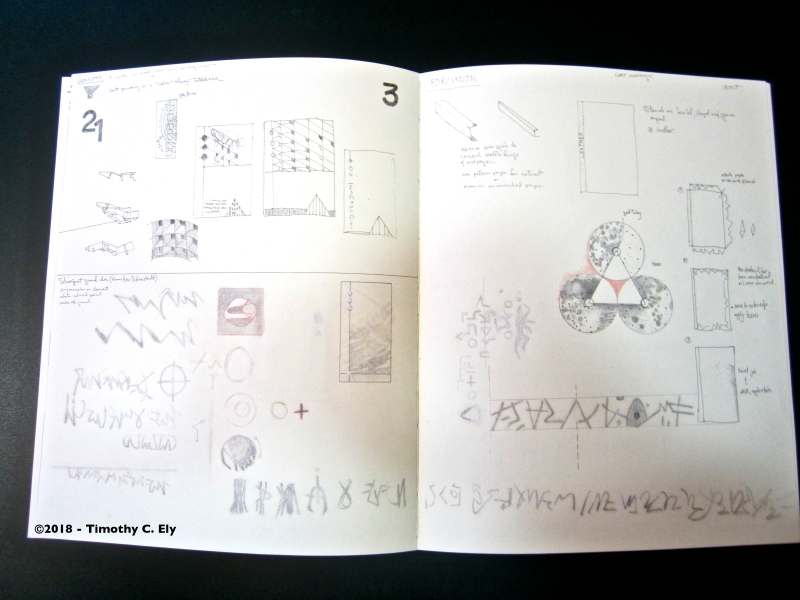
Inclusions
Around 1968, in my second year of college, I met Richard Simonson. He was an avid diarist and a well-read free lance art historian who also made books and recorded events, ideas, collages and photographs. I sensed a great capacity in this and was inspired to follow his model. We would be friends and adventurers for decades and he always carried a small notebook. Always jotting things down was, to me, a very cool thing to do. He was about a decade older than I, worked as an engineering draftsman and illustrated to me that acts of precision would pay off.
After a period of working these books, I decided that whatever went into the sketchbooks I kept was to be of a type to be open to public scrutiny. This choice expanded the value of these books and opened a range of ways that I use them.
A great deal of the work in my sketchbooks concerns developments of stand-alone drawings, books, bindings, binding methods and ideas. An overview of my sketchbooks reveals to me my biases in the moment, how they changed and what replaced them!
They also contain salient quotes and citations which I feel must be assimilated. The best assimilation comes from writing them down and advancing them from time to time by rewriting them in a later book. Eventually the quotes become part of my personal matrix.
 Sketchbook as Memory
Sketchbook as Memory
My sketchbook custom, in part, has to do with memory. I once read that “if it isn’t written down, it never happened.” So, of course, I wrote that down. Then I kept drawing or writing things down.
This is based on neurological truth. Our memory struggles with the bits and pieces of things it keeps and in sorting things to be easily recalled. When we annotate our day on something like paper (writing, sketching, or in an otherwise focused way), it becomes recorded in a way that we can effectively recall later.
Sketchbook as Tool of Self Transformation
Self transformation is our struggle to see or command the world around us. And I make the claim that books of all kinds can raise the consciousness of groups far more evenly than single player acts such as fasting or meditation. Working or reading from any book means one is not working alone. In fact, individual acts of level raising are both individual and subjective, which means they often degrade when discussed.
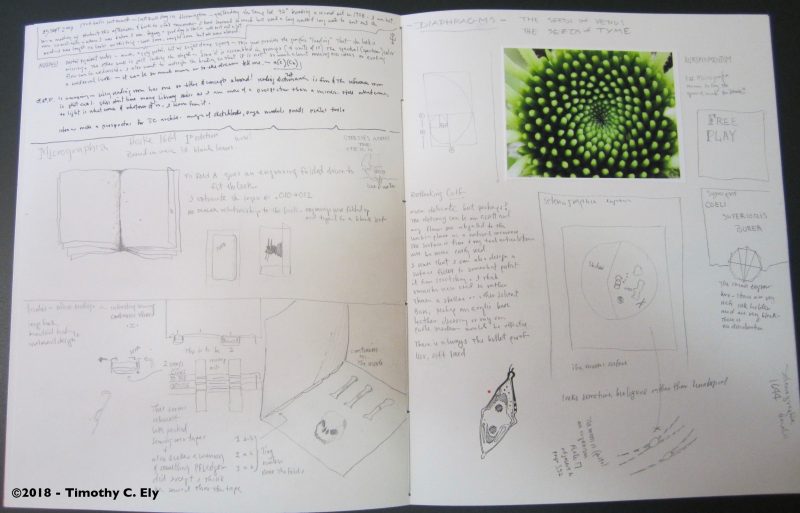 Individuals may be changed or alerted to the possibility of transformation more dramatically by drawing and writing. Nothing is universal of course, but I have seen it successfully operate more times than not – so I have some confirmation this is an opportunity in keeping a sketchbook.
Individuals may be changed or alerted to the possibility of transformation more dramatically by drawing and writing. Nothing is universal of course, but I have seen it successfully operate more times than not – so I have some confirmation this is an opportunity in keeping a sketchbook.

Quality of Thought, Quality of Making
I used commercial sketchbooks long before I knew much about books structures, paper types and quality. These books degraded quickly. And my daily workouts in these books osmotically taught me much about book behavior. Even after I began making manuscript books, I was resistant to making sketchbooks. It remains an elusive mystery as to why.
Many of us, though, end up with notions taunting us like ‘’this doesn’t matter’’ or ‘’nothing will come of this plan’’ or, one of mine at that time was, “if I make a sketchbook of high standard, it will be too precious to use.”

Sketchbook 62 In Progress
Yet after drawing in the first sketchbook of my own making, I realized that the correct paper choice feeds my hand, tools and ideas. A well made, beautiful crazy book is a delight to work in and activates connections not otherwise seen.
Observance
I believe our lives to be important so they deserve to be embraced in a kind of journal, diary, or sketchbook activity. It is a serious endeavor.
Through my teaching of bookbinding and the making of sketchbooks, I wish to encourage my students to “write down the river of existence, for it is real.” None of us can know in advance what form the effect of this work will take for the future doesn’t exist. We can however leave a set of tracks behind for someone to follow. I have observed this to be true. Write down your lives.
The merest shred of handwriting from my grandfather thrills me and I would give much to glimpse what he was thinking about at the early part of the twentieth century. It is difficult to piece together a picture puzzle of a life that has passed and so we tease the assembly of the historical image by grasping those notes left behind for us.
Journals, diaries, and sketchbooks offer fragments we can follow to comprehend lives well lived. A favorite memory of mine was reading from a small notebook diary of an American soldier in World War I. Daily he would write, but never his deeper thoughts. Most often he expressed a wish for dry socks. I cannot forget reading that book. I have some understanding of the mechanics of that war but this book cemented for me the reality of standing in water, outside for weeks on end waiting for a devastating end that was imagined to come. This unspeakable horror could only be understood in this small note book carried near the heart.
Schemes
The sketchbooks I kept in grad school led to the work entitled “Strange Wings or Over the Nooksack Valley” — the books, a two-volume set, which formally turned me into a bookmaker. These two commercial books were made up of a satisfactory paper and while working from Thompkin’s THE PRACTICE OF TEMPERA PAINTING, I came upon the idea of establishing the value schematic of a tempera painting all in dilutions of India ink. This technical breakthrough was astounding, for I began to fill my technical pens with a dilution and each time a line crossed another line, the value toward darkness would increase.
My robotic flyers in The Nooksack Valley books [a site of a conceptual visitation] were drawn with these veils of inky gray. They proved difficult to photograph but were delicate and delirious in a way which simply would not have worked as completely black ink drawings — something was going on. I think I was becoming aware of the folio to eye relationship. The scale I favored was intimate. Books are not read from across the room. They are private and deeply personal spaces.
Ron Carraher, my advisor (a photo/film guy) and I often discussed sequence in making images. He wrote and photographed backroad objects and untrained visionary work — what would later be called “American primitive.” He created photo essays, published these fine books of images and I think built his house on the profits.
In one of our meetings he spotted one of my sketchbooks and the Nooksack Valley experiments and suggested that ‘’this was my real work’’ and that I could consider gathering and publishing my drawings. He suggested that I make books. His was a practical suggestion. I understood precisely what he meant yet seemingly subconsciously refused to embrace the many considerations about the problems of publishing (production, capital outlay, marketing and all of that attendant clobber).
 What I chose to hear, instead, was clear as a bell — that I should make books. In other words, to make a sequential series of idea-drawings using the sumptuous materials I favor and then bind those into a grand manuscript book. I was looking for presence, like cinema in the form of a book. No editions here, not much repeatable production, just one book. I was already in that mode with my commercial books and I would work out methods of making elegant dust jackets which gave the Nooksack books a crisp commercial appeal. But I was some distance out from making a book from the ground up.
What I chose to hear, instead, was clear as a bell — that I should make books. In other words, to make a sequential series of idea-drawings using the sumptuous materials I favor and then bind those into a grand manuscript book. I was looking for presence, like cinema in the form of a book. No editions here, not much repeatable production, just one book. I was already in that mode with my commercial books and I would work out methods of making elegant dust jackets which gave the Nooksack books a crisp commercial appeal. But I was some distance out from making a book from the ground up.
The ideas here had tremendous resonance. This work could be done using mostly all pre-Gutenberg tech. Thus in my mind on that day, what I’ve come to call “the manuscript book” was formed. I had a head full of ideas and a certainty that the path was cluttered and unclear.
After he left our meeting, I walked to the University Bookstore and purchased A.W. Lewis’ BASIC BOOKBINDING…my first bookbinding manual.
I Now Am at Book 125
Books up to volume 28 are store bought, 29 thru 38 except for 32 and 37 were made by Jace Graf in Austin, Texas. 32 is a book of quotations and references I find useful and 37 is a small 5.5” x 7.5” book I made to take to England in 1999. It begins and ends with that trip.
Otherwise all the books are of my making and approximately 9” x 11”. They are experimental and used to test things out. They are sometimes devoted to processes that need elaboration. Book 64 explores the weavers knot and the book, sewn on colored threads, has one weavers knot per section. Big drawings of the knot and small sequences really got the knot into my muscle memory. I discovered a new way to tie it as well. 
A sketchbook is a place for discovery and innovation and not just reportage. When there is a structural exploration or new technique tested in the sketchbook, the book contains an explanation. Early on, my art history teachers spoke of sketchbooks as the starting places for paintings. It’s as if to say, every painting of merit had before it a sketch or series of plans later realized in paint and on an ambitious scale. I like this idea and all that surrounds it; I like how it occurs as drawings NOT in books or binders but as stand-alone preparations or cartoons for transfer.
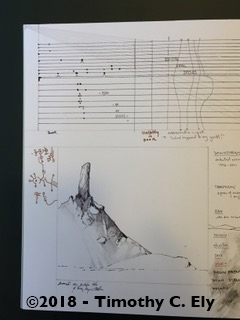 However, I was not doing that kind of painting. I rarely plan a painting but I do make thumb- and fingernail sketches. What I was interested in was that my sketchbooks be interesting to me at any point. I decided after diagraming a radio circuit, that the books should reveal many of my interests. Since the insertion of that idea into the game occurred, my books began to express ideas about and record things like: Meals, Food, Receipts, Numbers and Stats (of all kinds), Deities Seen, Diagrams, Photos, Music Notations, Plans, Visitations, Maps, UFO Sightings, Clouds, Images of Use, Shards, Formulas, Geometric Axioms, Samples, Color Swathes and Swatches, Recipes, Quotes, Revelations, Spacetime Locations [where are you?], Obits, Dreams, Oblique Projections, Fantasies, Drawing for Drawing, Studies for Other Side Issue Works, Lists, Scales, Geological Oddities, Landscape Notes, Deep Sea Fishing, Rubber Stamp Collages (as riggers and triggers), Submarines, Knots, Grids, Graph Paper Inserts with Drawings, Chord Studies….. And this is just a start.
However, I was not doing that kind of painting. I rarely plan a painting but I do make thumb- and fingernail sketches. What I was interested in was that my sketchbooks be interesting to me at any point. I decided after diagraming a radio circuit, that the books should reveal many of my interests. Since the insertion of that idea into the game occurred, my books began to express ideas about and record things like: Meals, Food, Receipts, Numbers and Stats (of all kinds), Deities Seen, Diagrams, Photos, Music Notations, Plans, Visitations, Maps, UFO Sightings, Clouds, Images of Use, Shards, Formulas, Geometric Axioms, Samples, Color Swathes and Swatches, Recipes, Quotes, Revelations, Spacetime Locations [where are you?], Obits, Dreams, Oblique Projections, Fantasies, Drawing for Drawing, Studies for Other Side Issue Works, Lists, Scales, Geological Oddities, Landscape Notes, Deep Sea Fishing, Rubber Stamp Collages (as riggers and triggers), Submarines, Knots, Grids, Graph Paper Inserts with Drawings, Chord Studies….. And this is just a start.
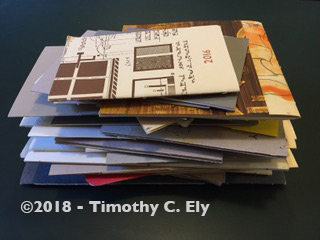 The number 125 counts only the core set of bound sketchbooks. There are also digressions — piles of small, single-section books are all over the house. They are dated internally by note as they progress but not numbered and are not sequential — they wander. These are gathered up as I leave the house so that I am never without some kind of writing surface.
The number 125 counts only the core set of bound sketchbooks. There are also digressions — piles of small, single-section books are all over the house. They are dated internally by note as they progress but not numbered and are not sequential — they wander. These are gathered up as I leave the house so that I am never without some kind of writing surface. 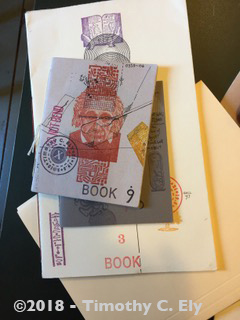
I also work in ring binders with a mixed grill of many different papers to experiment and find the best one for a need. I carry them and if a drawing is simply disagreeable, it’s easily removed. These drawings can also often be larger fold-outs — detailing ambitious books I am working on.
I also devote binders to specific processes. One is for gilding and working out tooling designs, another is for printmaking and pretty much lives in the print shop. 

 There is a book devoted to guitar work with designs for painted tops, bracing measurements and even small bits of notation and chord progressions. The binders also carry plastic sleeves with images and samples and small playing card-sized fragments of all sorts of detritus, drawings, envelope fragments with tiny brilliant notations, prints and bits of skin mostly.
There is a book devoted to guitar work with designs for painted tops, bracing measurements and even small bits of notation and chord progressions. The binders also carry plastic sleeves with images and samples and small playing card-sized fragments of all sorts of detritus, drawings, envelope fragments with tiny brilliant notations, prints and bits of skin mostly.
My Most Favored Tool
When asked, I think of the half-century project of sketchbook discipline as my most favored tool.
There’s an excellent body of psychological work showing how tools extend the human mind. A mathematician’s notepaper, for example, participates closely with their mind as they find solutions. Just so, sketchbooks are an extension of the mind, hand, and eye — they are as integrated into my work as any tool.
Sketchbooks are not, naturally, the only significant tool, but when mixed with the idea of purposeful play, deep reading of salient texts, and plein air meditations, sketchbooks have helped me always to construct a viable way to move ahead on the track.
©2018 Timothy C. Ely – All Rights Reserved
That is one rich meal of an essay. I can’t help but think how wonderful it would be to have it in a small booklet produced by you.
LikeLiked by 1 person
Ah, Tim, you’ve done it again: juiced me up to work even more in my sketchbooks than I already am and reinforced my own conviction that sketchbooks are Ground Zero for all the other creative work I do. I loved this essay. Thank you.
LikeLike
Thanks very much for the comments! I look forward to expanding these ideas. I agree that they are ground zero- the consistency of them over so many years organizes the potency of seeing all of the dissonant [sometimes] parts come together. I feel like we spend a lot of time in the dark, trying to figure things out and journals, diaries and these retrospective self-generated offerings nail it down.Stay tuned!
LikeLike
Bonjour Timothy. Great article about sketchbooks. That is pretty rare.
I share it on my blog today (in french).
https://gycouture.blogspot.com/2018/10/50-ans-de-carnets-de-timothy.html
thank you.
LikeLike
Thank you so much! I did not realize it was rare but then I sort of keep my head down and work. Articulating ideas about this has formed up a few new directions as well. lets stay in touch! T.
LikeLike
Pingback: Rhizomes, Carbon and Graphite: Contemplations on a Sketchbook, Part 2 | A Planetary Collage -Timothy C. Ely
Pingback: Friday Night Flicks: TX83-Timothy C. Ely | Byopia Press
Pingback: Registration Open for Summer Workshop — The Sketchbook: Thoughts and Actions. | A Planetary Collage - Timothy C. Ely